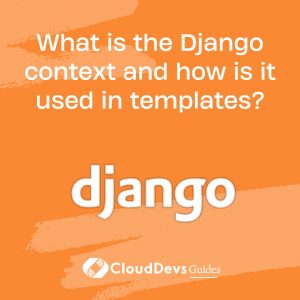Django Q & A
What is the Django context and how is it used in templates?
The Django context is a crucial component of Django’s templating system, responsible for passing data from views to templates. It provides a way to make dynamic data available for rendering in HTML templates. Here’s an explanation of what the Django context is and how it’s used in templates:
- What is the Django Context? The Django context is essentially a Python dictionary containing key-value pairs, where keys represent variable names, and values are the data associated with those variables. In Django, views are responsible for populating this context dictionary with data extracted from models, databases, or any other data source.
- How is it Used in Templates? Once the context dictionary is populated in a view, it’s passed to the template as a parameter when rendering the template. This makes the data within the context accessible within the template, allowing you to dynamically generate HTML content based on that data.
- Template Tag Usage: In templates, you can access the data within the context using template tags enclosed within curly braces `{}`. For example, if you have a variable named `user` in the context, you can display it in the template as `{{ user }}`.
- Iteration and Control Flow: The Django context is particularly useful for iterating through lists or querysets, conditionally rendering content, and performing other dynamic operations within templates. You can use template tags like `{% for %}`, `{% if %}`, and `{% block %}` to control the flow of your templates based on the data in the context.
- Context Processors: Django also provides context processors, which are functions that add specific data to the context globally for every template. This is useful for adding data that is common to many views, such as user authentication status or site-wide configuration settings.
The Django context is a fundamental mechanism for passing data from views to templates, enabling the dynamic generation of HTML content. It allows developers to keep the presentation logic separate from the application logic, resulting in clean and maintainable code for building web applications with Django.

Previously at


Argentina

GMT+2
Experienced Full-stack Developer with a focus on Django, having 7 years of expertise. Worked on diverse projects, utilizing React, Python, Django, and more.


